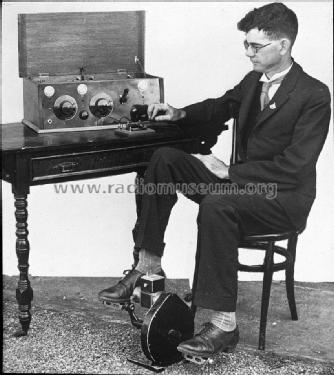Pedal Wireless Baby
Traeger Transceivers Pty. Ltd.; Adelaide
- Pays
- Australie
- Fabricant / Marque
- Traeger Transceivers Pty. Ltd.; Adelaide
- Année
- 1928
- Catégorie
- Emetteur / récepteur commercial (TRX non amateur)
- Radiomuseum.org ID
- 275691
- No. de tubes
- 3
- Principe général
- Récepteur TRF en général (avec ou sans réaction inconnu)
- Gammes d'ondes
- PO et OC
- Tension / type courant
- Batteries / Alim. BT séparée avec fiche / 2 × 1.5 & 9 or 180 Volt
- Haut-parleur
- - Seulement pour écouteur
- Matière
- Boitier en bois
- De Radiomuseum.org
- Modèle: Pedal Wireless Baby - Traeger Transceivers Pty. Ltd.
- Forme
- Modèle de table profil bas (grand modèle).
- Remarques
-
Alf Taeger with help from Harry Kauper built the first Pedal Transceiver in 1928 and the first practical test took place in November. Six Pedal Wirelesses were built in 1929, for the Air Medical service, the predecessor to the Royal flying Doctor Service.
The transceiver used a B205 triode as a crystal oscillator, output stage with an RF output of 1.5 W.
It transmitted Morse code on a frequency of 2230 kHz. Morse was used because voice transmission was not practical at the time due to the higher power consumption required. Low power battery valves suitable for voice transmission did not become available till mid-1930’s.
The 2 valve regenerative receiver used two A141 tetrodes. The receiver covered the broadcast band up to approximately 4 MHz.
The filament supply was from two 1.5 V dry batteries and one 9 V battery. Treager developed a pedal generator to supply the B+ producing 180 V.
Silicon Chip magazine of November 2010 describes a replica of this radio built by John Sheard.
- Littérature
- Silicon Chip magazine, November 2010, Page 98
- Auteur
- Modèle crée par Gary Cowans. Voir les propositions de modification pour les contributeurs supplémentaires.
- D'autres Modèles
-
Vous pourrez trouver sous ce lien 6 modèles d'appareils, 4 avec des images et 1 avec des schémas.
Tous les appareils de Traeger Transceivers Pty. Ltd.; Adelaide
Littérature
Le modèle Pedal Wireless est documenté dans la littérature suivante.

